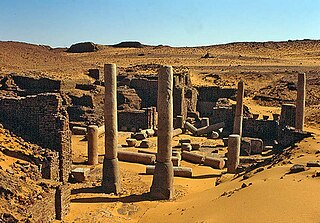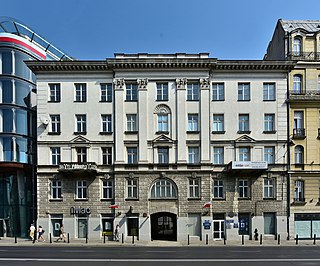
Kazimierz Józef Marian Michałowski was a Polish archaeologist and Egyptologist, art historian, member of the Polish Academy of Sciences, professor ordinarius of the University of Warsaw as well as the founder of the Polish school of Mediterranean archaeology and a precursor of Nubiology.

Old Dongola is a deserted town in what is now Northern State, Sudan, located on the east bank of the Nile opposite the Wadi Howar. An important city in medieval Nubia, and the departure point for caravans west to Darfur and Kordofan, from the fourth to the fourteenth century Old Dongola was the capital of the Makurian state. A Polish archaeological team has been excavating the town since 1964.

Soba is an archaeological site and former town in what is now central Sudan. Three kingdoms existed in medieval Nubia: Nobadia with the capital in Faras, Makuria with the capital in Dongola, and Alodia (Alwa) with the capital in Soba. The latter used to be the capital of the medieval Nubian kingdom of Alodia from the sixth century until around 1500. E. A. Wallis Budge identified it with a group of ruins on the Blue Nile 19 kilometres (12 mi) from Khartoum, where there are remains of a Meroitic temple that had been converted into a Christian church.

Marina, also Marina El Alamein , ancient Leukaspis or Antiphrae, is an upscale resort town catering mainly to the Egyptian upper class. It is located on the northern coast of Egypt, with an 11 km (6.8 mi) long beach, about 300 km (190 mi) away from Cairo, in the El Alamein area.
Tell Arbid is an ancient Near East archaeological site in the Khabur River Basin region of Al-Hasakah Governorate, Syria, about 50 kilometers north northeast of modern Al-Hasakah. It is located 45 kilometers south of Tell Mozan, the site of ancient Urkesh and about 15 kilometers from the site of Chagar Bazar. The Halafian site of Tell Arbid Abyad is a short distance away.
The International Congress on the Archaeology of the Ancient Near East (ICAANE) is a biennial conference cycle initiated by archaeologists from several European universities. The first ICAANE took place in Rome in 1998. Since then the congress has been held every other spring at a different European university. The host of each ICAANE is chosen two years in advance by the ICAANE Scientific Committee. In 2018, in Munich, the decision of arranging the next congress was taken and the University of Bologna was chosen as the host of the 12 ICAANE. This event was subsequently delayed to 2021 as a result of the COVID-19 crisis.

The Polish Centre of Mediterranean Archaeology University of Warsaw operates as an independent research institute of the University of Warsaw under the present name since 1990. It is dedicated to organizing, implementing and coordinating archaeological research, both excavations and study projects, as well as conservation, reconstruction and restoration projects, in northeastern Africa, the Near East and Cyprus. Projects include sites covering a broad chronological spectrum from the dawn of civilization through all the historic periods of the ancient Mediterranean civilizations to Late Antiquity and early Islam. Tasks beside fieldwork include comprehensive documentation of finds, archives management and publication of the results in keeping with international research standards. The PCMA manages the Research Centre in Cairo and Polish Archaeological Unit in Khartoum.
Stefan Karol Jakobielski is a Polish historian, archaeologist, philologist, epigraphist. One of the pioneers of nubiology. He participated in archaeological research in Faras, Tell Atrib, Palmyra, Deir el-Bahari and Qasr Ibrim; directed the archaeological works at Old Dongola.

The Research Centre in Cairo, Polish Centre of Mediterranean Archaeology University of Warsaw, is the only Polish scientific research institution in Africa and the Middle East, where it has operated since 1959 in Cairo. The mission of the Research Centre is to develop and expand Polish research in the region, particularly in the Nile Valley. It is operated by the Polish Centre of Mediterranean Archaeology, an independent research institute of the University of Warsaw. The PCMA Cairo Research Centre is located in two buildings situated in close proximity to one another in the Cairo Heliopolis district — in antiquity the centre of a religious cult and the location of the Egypt's reputedly largest temple.
Bahra 1 is an archaeological site in the Subiya region on the coast of Kuwait Bay (Kuwait) associated with the Ubaid culture. It is one of the earliest Ubaid culture settlements in the Persian Gulf region, about 5500–4900 BC.
Bijân Island is an island in the middle Euphrates, in the historical land of Suhum. It belongs to a group of islands on which archaeological sites have been recorded.
Subiya (Al-Subiyah) is a region in northern Kuwait on the north coast of Kuwait Bay (Kuwait), consisting of several micro-regions: Bahra, H3, Nahdain, Radha, Muhaita, Mughaira, Dubaij, and Ras al-Subiyah. The area features archaeological sites with tumuli graves, settlements, campsites, wells, and shell middens. Most of the tumuli date to the Early and Middle Bronze Age. Subiya is the location of the Silk City project, the project's first phase was launched in May 2019.
Tell Djassa is an archaeological site in Syria, in the Khabur River basin, in the area of the Khabur Triangle in Upper Mesopotamia.
Tell Abu Hafur is an archaeological site in Syria, in the Khabur River basin, in the area of the Khabur Triangle in Upper Mesopotamia.
Tell Saadiya is a tell, or archaeological settlement mound, in Diyala Governorate (Iraq).
Tell Rad Shaqrah was a fortified rural settlement in Syria, in ancient Upper Mesopotamia. It is located on the northern bank of the Khabur River, about 15 kilometers from Hassake (Al-Hasaka).
Tell Raffaan is an archaeological site in Iraq, in ancient Upper Mesopotamia, in the valley of the Tigris River.
Tell Rijim is an archaeological site in Iraq, in ancient Upper Mesopotamia, in the valley of the Tigris River, about 25 kilometers to the north-west of Eski Mosul.
Qumayrah Valley – a valley in northern Oman, in the Al-Hajar Mountains in the Ad Dhahirah Governorate. It stretches for about 10 kilometers between the villages of Ayn Bani Sa’dah (al-Ayn), Qumayrah and Bilt.

Faculty of Archaeology, University of Warsaw (WAUW) is a faculty of the University of Warsaw, established on September 1, 2020, through the transformation of the Institute of Archaeology, which operated as part of the now-defunct Faculty of History. The Faculty is based in the Szkoła Główna Warszawska building. It is the largest archaeological institution in Poland, comprises 17 departments and 7 laboratories with a staff of about 100. The Faculty provides education in various branches of modern archaeology and related sciences to over 1500 students from various fields of study: Ancient Egypt, Ancient America, Classical Archaeology, and Ancient Near East. The Archaeology program at the University of Warsaw is placed between 51st and 100th worldwide in Quacquarelli Symonds World University Ranking (QS)






